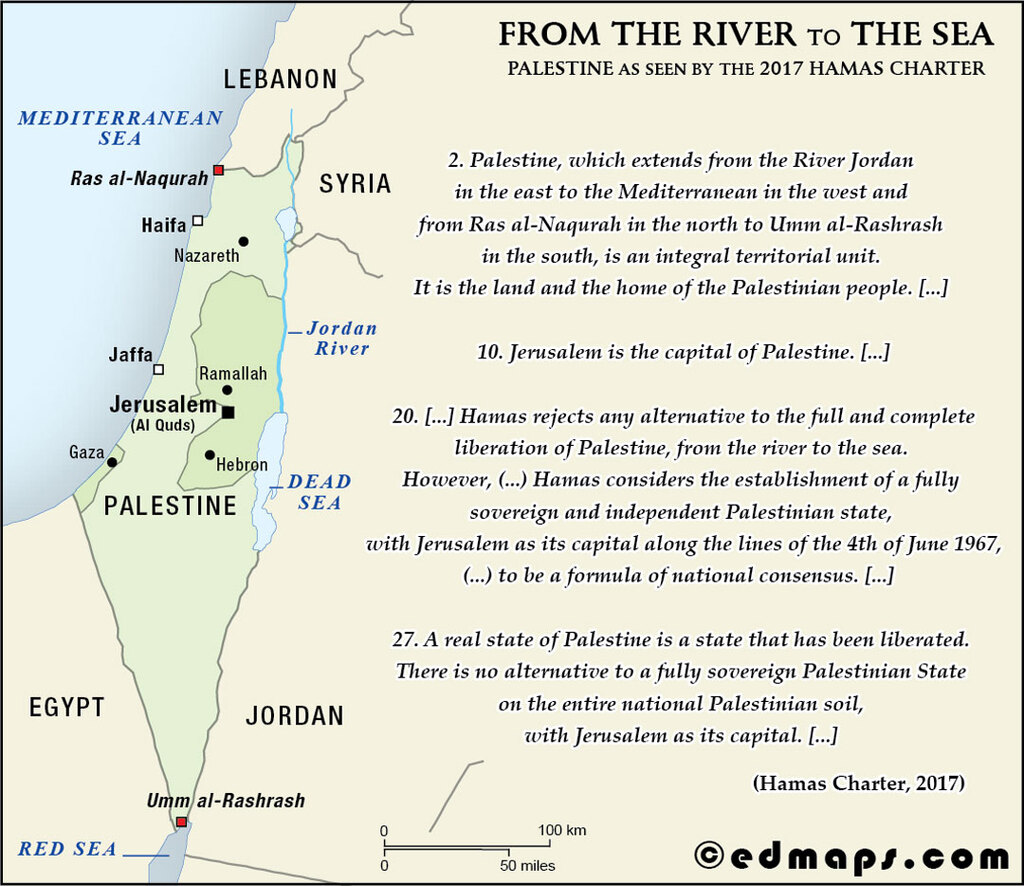
"From the river to the sea" — this phrase encapsulates Hamas's territorial vision in its 2017 charter, defining Palestine as stretching from the Jordan River to the Mediterranean Sea. Despite rhetorical modifications from 1988, the charter maintains maximalist claims over historic Palestine, encompassing present-day Israel, the West Bank, and Gaza. Hamas designates Jerusalem as Palestine's capital, declares Israel's establishment "entirely illegal," and demands "full and complete liberation." While acknowledging potential interim arrangements on 1967 borders, the charter preserves the ultimate objective of eliminating Israeli statehood, rejecting all partition plans and international frameworks that legitimized Israel's existence, leaving no basis for permanent coexistence or compromise.

Hamas's revised charter of 2017 articulated Palestinian territorial claims that, while rhetorically modified from its 1988 predecessor, maintained maximalist demands for complete sovereignty over historic Palestine. The document defined Palestine's boundaries with geographic precision: from Ras al-Naqurah in the north to Umm al-Rashrash in the south, and from the Jordan River to the Mediterranean Sea. This formulation encompassed approximately 10,000 square miles, including all of present-day Israel, the West Bank, and Gaza Strip.
Article 2 declared unequivocally: "Palestine, which extends from the River Jordan in the east to the Mediterranean in the west and from Ras al-Naqurah in the north to Umm al-Rashrash in the south, is an integral territorial unit." Ras al-Naqurah marks Lebanon's northern border, while Umm al-Rashrash — the Arabic name for Eilat — sits at the Gulf of Aqaba's northern tip. This precise geographical demarcation rejected all partition plans, the 1949 armistice lines, and Israel's internationally recognized borders, asserting that the entire territory constituted inalienable Palestinian land.
The charter's nationalist demands centered on complete liberation and self-determination. Article 19 proclaimed Palestine as "the land of the Arab Palestinian people" and declared that "establishing 'Israel' is entirely illegal." Unlike the 1988 charter's explicitly religious framing, the 2017 document emphasized national liberation language, though it retained Islamic references. Article 20 designated Jerusalem—specifically Al-Quds—as Palestine's capital, rejecting Israeli sovereignty over any part of the city and asserting exclusive Palestinian ownership of its religious and national significance.
The ethnic composition envisioned by Hamas posed fundamental challenges to Israel's Jewish population of over 6 million. While the charter attempted rhetorical distinction between Judaism and Zionism — stating that Hamas's conflict was with the Zionist project rather than Jews because of their religion — its practical implications remained stark. Article 20 declared that Hamas "rejects any alternative to the full and complete liberation of Palestine, from the river to the sea," explicitly refusing compromise or territorial partition.
The conflict with Zionism was characterized as existential and non-negotiable. Article 18 stated: "The following are null and void: the Balfour Declaration, the British Mandate Document, the UN Palestine Partition Resolution, and whatever resolutions and measures that derive from them or are similar to them." This wholesale rejection of international frameworks that created Israel left no legal or diplomatic basis for its existence in Hamas's vision.
Significantly, the charter distinguished between interim political positions and ultimate objectives. Article 20 acknowledged that establishing a Palestinian state on 1967 borders could be accepted without recognizing Israel's legitimacy or abandoning claims to the entire territory — a tactical concession that preserved maximalist goals while allowing pragmatic engagement. This formulation maintained the ideological commitment to complete territorial liberation while creating strategic flexibility, positioning the elimination of Israel as an unchanged long-term objective despite any temporary arrangements.
Anyway, the Hamas surprise attack on Israel on October 7, 2023, showed the limits of this "strategic flexibility" and marked the beginning of a new era for the region: as the Hamas main objective is the establishment of an Islamic State of Palestine ''from the river to the sea'' and from Ras al-Naqurah to Umm al-Rashrash and the destruction of the State of Israel, the chances for peace in Palestine seem to be now zero to none.